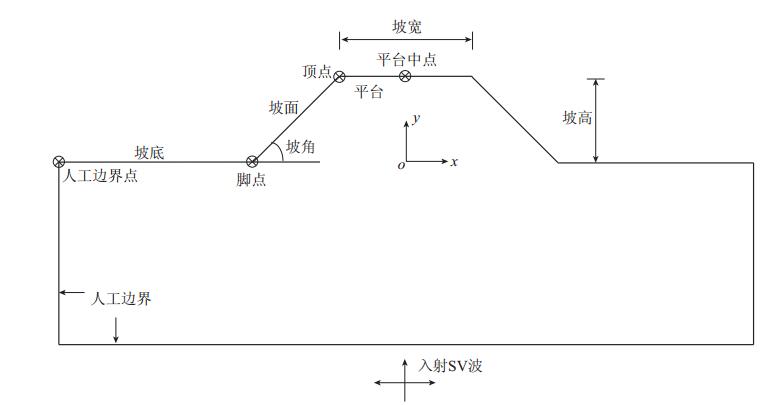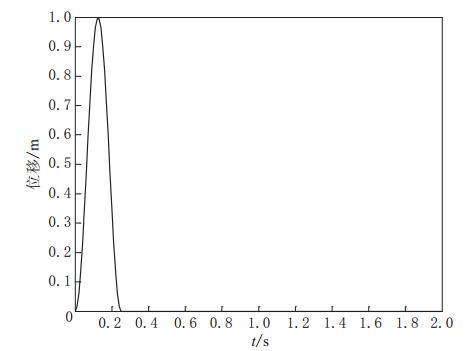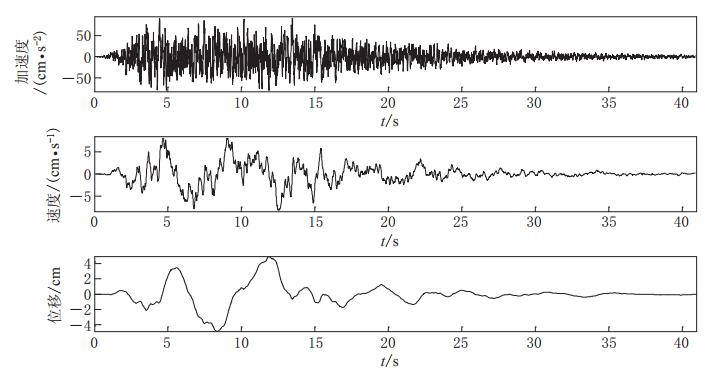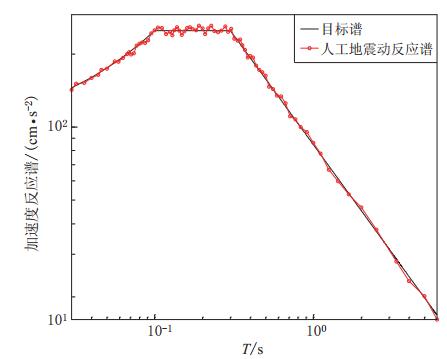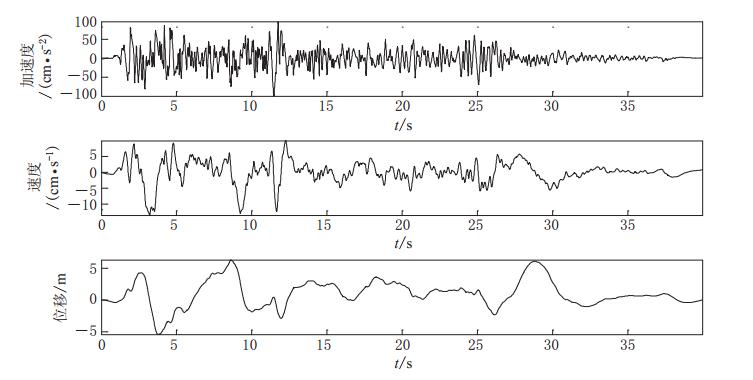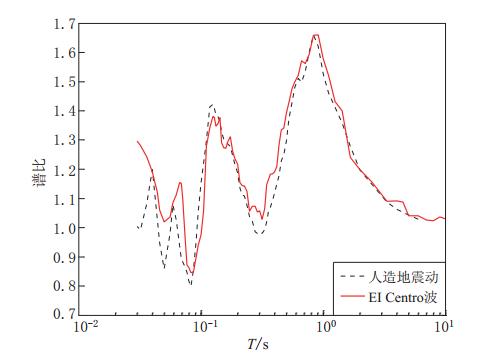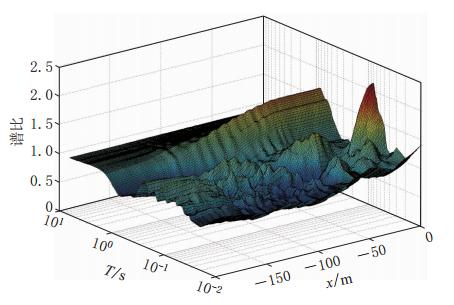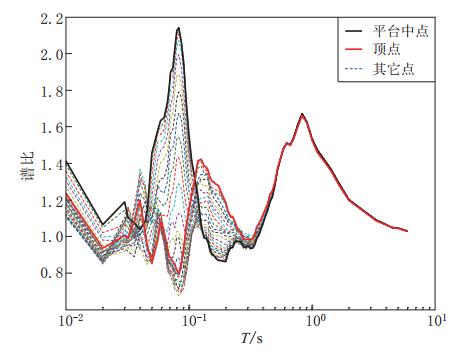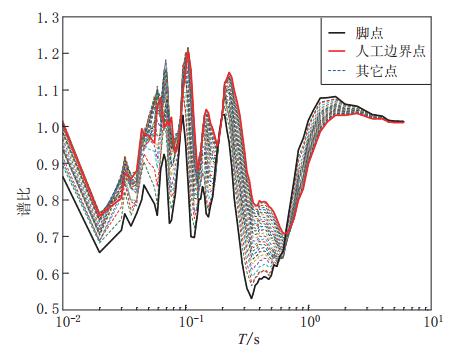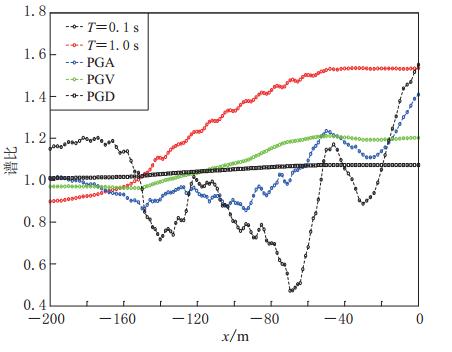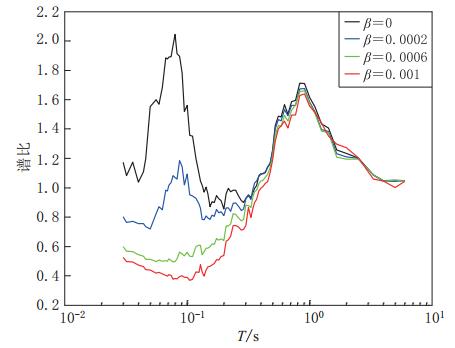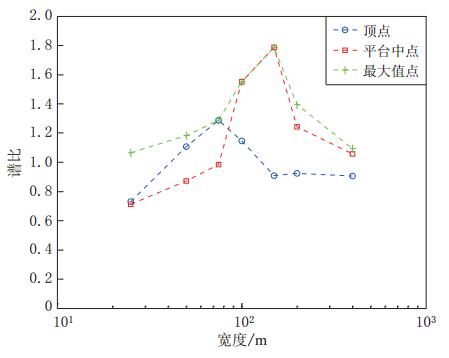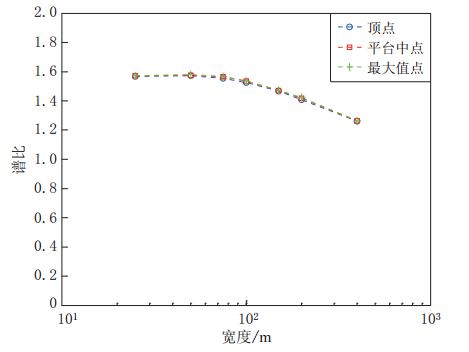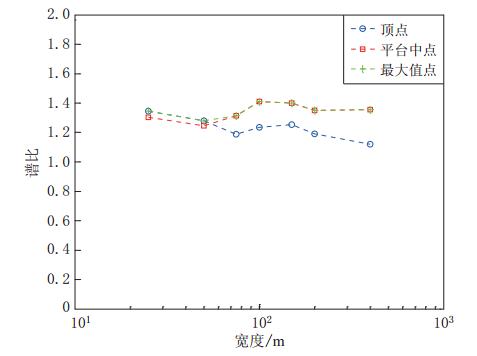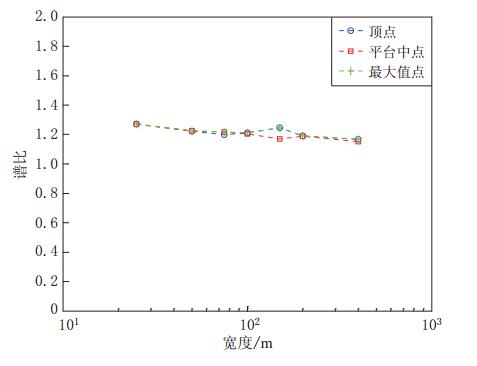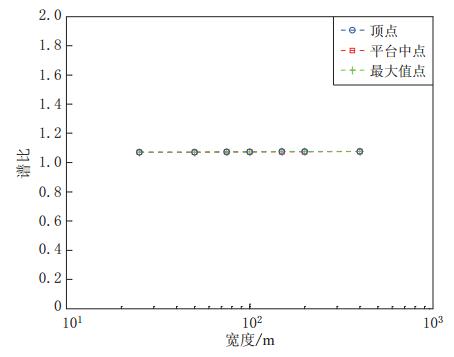Analysis of terrain effect on the properties of ground motion
-
摘要: 采用基于ABAQUS平台的显式有限元动力学分析方法,结合人工黏弹性边界理论,研究了局部凸起地形对地震动特性(包括反应谱、峰值加速度、峰值速度和峰值位移等)的影响,分析了台地宽度对地形放大效应的影响.结果表明:凸起地形平台段空间点地震动受地形效应影响较大,在零阻尼条件下,其谱比曲线呈双峰特点,.8—0.9s的中长周期段谱比达到一个较大值1.6,在0.08—0.09s的高频段谱比超过2.0,且最大值出现在平台中点;对于凸起地形斜坡段,在大部分周期点处,顶点的谱比高于其它斜坡点,而且在周期超过0.4s的频段,斜坡段观测点的谱比表现出较明显的规律性,即越靠近顶点的观测点,其谱比值越大;坡底段地表不同观测点的谱比基本在脚点与计算边界点(人工边界点)对应的谱比值之间变化,在不同的频段均表现出较明显的规律性.凸起地形平台段宽度对地震动高频成分的放大效应具有较大影响,但只局限在一定的宽度范围内,随着宽度的增大,其对地形放大效应的影响逐渐减弱. 此外,台地宽度的变化对地震动峰值加速度的放大效应有一定的影响,而对峰值速度、峰值位移的放大效应的影响则不明显.Abstract: The explicit finite element analysis method combined with the artificial viscous-elastic boundary theory based on the platform ABAQUS is performed to evaluate the terrain effects on ground motion (such as the response spectrum, peak acceleration, peak velocity and peak displacement), and the influence of the terrain width on its amplification effects is studied. The results show that the ground motions on the platform are affected most seriously by the topography; in the zero damping conditions, the spectral ratio curves present the characteristics of double peaks,with their values being a higher value of 1.6 in the long period range of 0.8—0.9 s and exceeding 2 in the high-frequency range of 0.08—0.09 s, and the maximum ratio appearing at the midpoint of the platform. For the slope section, as to most natural periods of response spectrum, the spectral ratios of the vertices are higher than the other surface points on theslope.Inaddition,inthenatural period beyond 0.4 s, the spectral ratios of the spatial points on the slope show some regularity: the closer to the vertex the observation point, the greater the spectral ratio.Spectral ratios of different observation points on the bottom change between spectral ratios corresponding to basic foot point and those to the boundary point,ortheartificial boundary point, which is obvious in different frequency bands. The width of terrain imposes significant influence on its amplification effects on high-frequency componentsofgroundmotion.However, such influenceislimited in some range of width, and with the increase of width, the influence of width on the topographic amplification effects becomes weak. In addition, the width of terrain influences the amplification effect on the peak acceleration of ground motion to some extent, while its influences on the amplification effects on thepeakground velocity and peak ground displacement are not distinct.
-
本文在收集整理分析中国大陆1902—2014年132次板内浅源地震事件的相关数据(包括震级、 发震时间、 地点、 断层类型、 地震矩、 地表破裂长度、 余震分布长度、 波谱反演得到的震源处破裂长度等)的基础上,给出了震级与震源破裂长度和余震分布长度的经验公式,并对震级与破裂长度之间的相关性进行了分析. 表 1给出了本文所用部分地震序列的相关参数.
表 1 本文所用部分地震序列及其相关参数Table 1. Partial earthquake sequences of China and related parameters used in this paper序号 发震时刻 地点 北纬/° 东经/° M0/(1018 N·m) 中国MS 美国MS MW L1/km L2/km L3/km 断层类型 来源 年-月-日 时:分 1 1988-11-06 21:03 云南澜沧 22.9 99.8 36.6 7.6 7.3 7.0 70 70 右旋 邓起东等(1992) 2 1996-02-03 19:14 云南丽江 27.3 100.2 9.94 7.0 6.5 6.6 42 41 正 蒋海昆等(2007) 3 2008-03-21 06:33 新疆于田 35.6 81.6 54.3 7.3 7.3 7.1 31 正 徐锡伟等(2011) 4 2008-05-12 14:28 四川汶川 31.0 103.4 897 8.0 8.1 7.9 300 逆 张勇等(2008) 5 2010-04-14 07:49 青海玉树 33.2 96.6 7.1 6.9 65 65 走滑 陈立春等(2010) 6 2013-04-20 08:02 四川芦山 30.3 103.0 10.2 7.0 6.8 6.6 40 逆 苏金蓉等(2013) 7 2014-08-03 16:30 云南鲁甸 27.1 103.3 2.12 6.5 6.2 6.2 22 走滑 张广伟等(2014) 8 2014-10-07 21:49 云南景谷 23.4 100.5 1.89 6.6 6.1 6.1 20 左旋 徐甫坤等(2015) 注: M0为地震矩,L1表示地表破裂长度,L2表示余震长度,L3表示基于波谱方法得到的震源处破裂长度. 本文所用面波震级有两种: 一种是采用中国记录的面波震级(下文简称为中国面波震级)MS-China,另一种是采用美国地质调查局(USGS)和全球地震矩张量(global centroid moment tensor,简写为GCMT)目录所记录的面波震级(下文简称为美国面波震级)MS-US,数据均从USGS和GCMT网站上下载所得,其中1976年以前的MS-US引自USGS,1976年以后的MS-US引自GCMT. 所用矩震级也分为两部分: 1976年以后的地震事件矩震级MW引自GCMT,1976年之前的矩震级MW引自USGS,GCMT和相关文献. 所有矩震级均保留一位小数,参与回归分析.
图 1a给出了美国面波震级MS-US与矩震级MW的回归关系,可以看出: MS-US为5.5—7.7时,其值与MW基本相等; MS-US为4.5—5.5时,其值较MW整体偏小; MS-US>7.7时,其值较MW整体偏大. 图 1b给出了中国面波震级MS-China与矩震级MW的回归关系,可以看出,MS-China为4.5—8.6时,MS-China>MW,但随着震级的增大,这种差距在减小. 图 1c给出了MS-China与MS-US的对比,可以看出,二者的相对平均偏差为5.5%,最大绝对偏差为0.19,而且相对偏差大于10%的MS-China主要集中在4.5—6.0之间.
震源破裂长度的估算方法中,有两种应用得较多. 其一,采用余震空间分布的方法来确定; 其二,采用地震波资料反演震源参数,通过P波或S波的时频特性来求解震源的破裂参数(沈建文等,1990). 鉴于MS<6.0地震所造成的破裂不明显或位移不显著,本文选取MS6.0—8.6地震事件用于拟合震级与断层破裂长度的关系.
针对不同的断层类型,利用最小二乘法计算分析了中国面波震级(MS-China)、 美国面波震级(MS-US)、 平均面波震级(
S)、 矩震级与地表破裂长度、 余震破裂长度和基于波谱分析所获取的地下破裂长度之间的关系. 因MS-China与MS-US的偏差不大,这里仅给出平均面波震级 S与地表破裂长度和地下破裂长度之间的拟合表达式,具体列于表 2. 本文参考Wells和Coppersmith(1994)的方法,通过改变数组的大小来评估各种相关关系的稳定性,并通过在每组数据中抽出两组数据后观察其相关系数的变化来检测数据拟合的稳定性. 结果显示: 数据点为10个或10个以上时,震级与破裂长度之间的相关性较好,两组数据的回归系数在95%的置信水平下无明显区别,其相关系数的差值基本上都在小数点后两位; 8个数据点以下的回归则视为不稳定. 因此在地表破裂长度以及由波谱反演得到的地下破裂长度回归方程中仅分析走滑断层和所有断层两种情况下的回归公式,以便根据各个回归关系式的相关系数来评估震级与破裂长度之间的相关性. 表 2 震级与破裂长度的回归关系式Table 2. Regression relationship between magnitude and rupture length经验公式 断层类型 a b 相关系数 标准差 震级范围 样本数 MS=a+blgL1 走滑 5.7040 0.9871 0.774 0.2699 6.9—8.6 20 所有 5.9024 0.8954 0.823 0.2803 6.4—8.6 30 MW=a+blgL1 走滑 5.0865 1.2114 0.731 0.3766 6.4—8.6 21 所有 5.3162 1.1201 0.753 0.3906 6.0—8.6 29 MS=a+blgL2 走滑 3.7380 1.9259 0.899 0.3589 5.0—8.1 37 逆 4.2191 1.3478 0.786 0.4363 4.9—8.1 26 正 3.5181 1.7882 0.543 0.5912 4.9—7.3 10 所有 3.8235 1.7325 0.817 0.4594 4.9—8.1 78 MW=a+blgL2 走滑 3.7505 1.7830 0.898 0.3373 5.1—7.8 38 逆 4.2674 1.2002 0.816 0.3393 5.1—7.9 28 正 3.4062 1.8221 0.880 0.2941 5.0—7.0 16 所有 3.8005 1.6414 0.853 0.3746 5.0—7.9 82 MS=a+blgL3 走滑 3.5189 2.0049 0.833 0.5492 5.1—8.0 16 所有 3.5577 2.0162 0.812 0.5548 4.9—8.0 21 MW=a+blgL3 走滑 3.6598 1.8143 0.848 0.4343 5.2—7.7 20 所有 3.7433 1.7899 0.836 0.4259 5.2—7.7 25 注: 第一列经验公式中,L1表示地表破裂长度,L2表示余震破裂长度,L3表示基于波谱反演所得的地下破裂长度. 从表 2可以看出: 地表破裂长度与面波震级的相关性优于其与矩震级的相关性; 余震破裂长度和基于波谱反演所得地下破裂长度与矩震级的相关性优于其与面波震级相关性. 图 2a比较了本文所得经验公式与邓起东等(1992)给出的经验公式(以下简称邓式),可以看出,当MS为6.4—8.6时邓式所对应的地表破裂长度L1始终小于本文结果,并且随着震级的增大,由邓式计算出的破裂长度增大的速率大于本文公式,这可能是由于本文仅使用了1902年以后的地震数据并增加了最新的地震数据所致; 图 2b中,当MS>5.3时,本文结果大于龙锋等(2006)的经验公式所确定的地下破裂长度; 图 2c为本文结果与Wells和Coppersmith(1994)经验公式所得结果的比较,可以看出,本文经验公式所对应的由余震确定的地下破裂长度总体比Wells和Coppersmith(1994)所得结果大,但是随着震级的增大,这种差距在逐渐减小.
通过比较不同断层类型的回归方程来评估断层类型对破裂长度的影响,其结果表明,震级与破裂长度的回归方程在95%的置信水平上与断层类型无关,这与Wells和Coppersmith(1994)的结果相一致.
-
-
中华人民共和国建设部. 2010. GB50011-2010建筑抗震设计规范[S]. 北京: 中国建筑工业出版社, 21. Ministry of Construction of the People’s Republic of China. 2010. GB50011-2010 Code for Seismic Design of Buildings[S]. Beijing: China Building Industry Press, 21 (in Chinese).
-
期刊类型引用(7)
1. 郭纪盛,乔岳强,汤勇,余松,查雁鸿,胡庆,雷东宁,蔡永建. 长乐-诏安断裂带东支东山段晚更新世活动的年代学证据及其意义. 地质科技通报. 2024(01): 160-172 .  百度学术
百度学术
2. 吴羿锋,唐方头,姜旭东. 麦宿断裂地震地表破裂带的发震构造分析. 地震学报. 2024(05): 751-766 .  本站查看
本站查看
3. 左洪,梁明剑,江宁波,廖程,宫悦,王宇航,罗勇. 四川荣县—威远—资中地区显著地震活动及其破裂尺度研究. 四川地震. 2023(02): 12-17+32 .  百度学术
百度学术
4. 王文静,王健,周红. 基于多破裂方式的三河—平谷地震震级研究. 地震学报. 2023(05): 903-918 .  本站查看
本站查看
5. 王杰,盛俭,赵梦丹,王欣宇. 断层错动对隧道工程影响研究的若干进展. 防灾科技学院学报. 2021(04): 34-42 .  百度学术
百度学术
6. 胡敏章,郝洪涛,李辉,祝意青. 地震分析预报的重力变化异常指标分析. 中国地震. 2019(03): 417-430 .  百度学术
百度学术
7. 李成宏,李陶,栗广才,常华,方荣新. 加速度计及其融合高采样GNSS的低频信号测量特性研究. 大地测量与地球动力学. 2019(12): 1293-1298 .  百度学术
百度学术
其他类型引用(7)




 下载:
下载:


